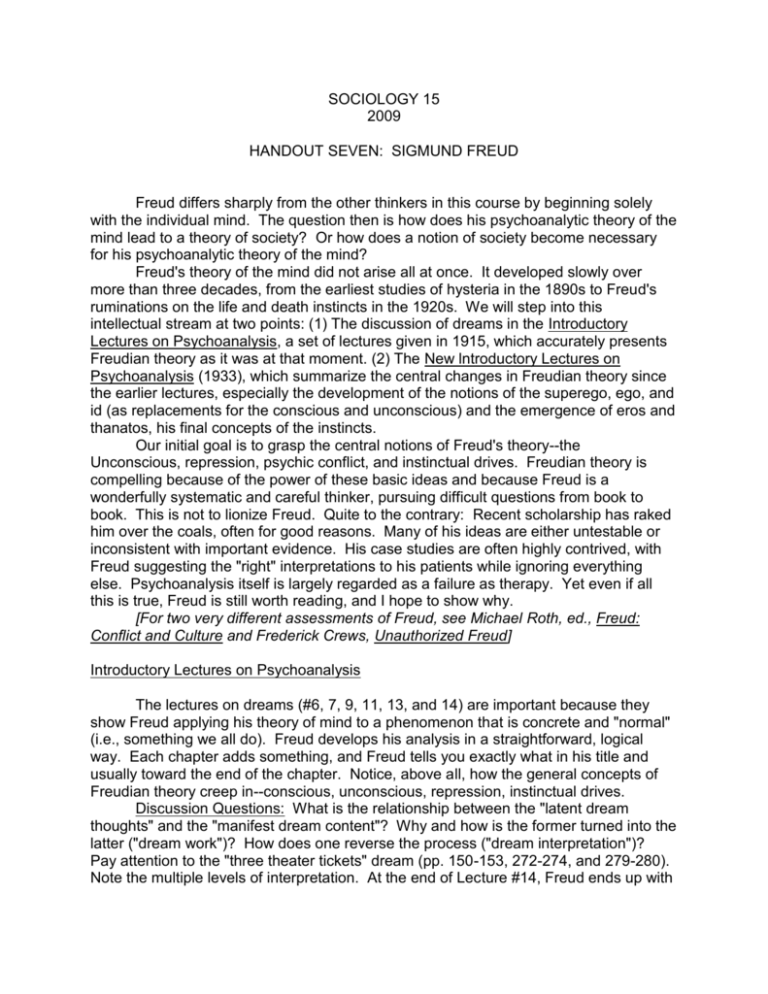
SOCIOLOGY 15
2009
HANDOUT SEVEN: SIGMUND FREUD
Freud differs sharply from the other thinkers in this course by beginning solely
with the individual mind. The question then is how does his psychoanalytic theory of the
mind lead to a theory of society? Or how does a notion of society become necessary
for his psychoanalytic theory of the mind?
Freud's theory of the mind did not arise all at once. It developed slowly over
more than three decades, from the earliest studies of hysteria in the 1890s to Freud's
ruminations on the life and death instincts in the 1920s. We will step into this
intellectual stream at two points: (1) The discussion of dreams in the Introductory
Lectures on Psychoanalysis, a set of lectures given in 1915, which accurately presents
Freudian theory as it was at that moment. (2) The New lntroductory Lectures on
Psychoanalysis (1933), which summarize the central changes in Freudian theory since
the earlier lectures, especially the development of the notions of the superego, ego, and
id (as replacements for the conscious and unconscious) and the emergence of eros and
thanatos, his final concepts of the instincts.
Our initial goal is to grasp the central notions of Freud's theory--the
Unconscious, repression, psychic conflict, and instinctual drives. Freudian theory is
compelling because of the power of these basic ideas and because Freud is a
wonderfully systematic and careful thinker, pursuing difficult questions from book to
book. This is not to lionize Freud. Quite to the contrary: Recent scholarship has raked
him over the coals, often for good reasons. Many of his ideas are either untestable or
inconsistent with important evidence. His case studies are often highly contrived, with
Freud suggesting the "right" interpretations to his patients while ignoring everything
else. Psychoanalysis itself is largely regarded as a failure as therapy. Yet even if all
this is true, Freud is still worth reading, and I hope to show why.
[For two very different assessments of Freud, see Michael Roth, ed., Freud:
Conflict and Culture and Frederick Crews, Unauthorized Freud]
Introductory Lectures on Psychoanalysis
The lectures on dreams (#6, 7, 9, 11, 13, and 14) are important because they
show Freud applying his theory of mind to a phenomenon that is concrete and "normal"
(i.e., something we all do). Freud develops his analysis in a straightforward, logical
way. Each chapter adds something, and Freud tells you exactly what in his title and
usually toward the end of the chapter. Notice, above all, how the general concepts of
Freudian theory creep in--conscious, unconscious, repression, instinctual drives.
Discussion Questions: What is the relationship between the "latent dream
thoughts" and the "manifest dream content"? Why and how is the former turned into the
latter ("dream work")? How does one reverse the process ("dream interpretation")?
Pay attention to the "three theater tickets" dream (pp. 150-153, 272-274, and 279-280).
Note the multiple levels of interpretation. At the end of Lecture #14, Freud ends up with
two distinct kinds of unconscious. How are they different from each other? How does
each figure in dreams?
New lntroductory Lectures
Lectures 31 and 32 discuss how Freud overhauled his theories in a series of
books in the 1920s (e.g., Beyond the Pleasure Principle, The Ego and The Id, The
Problem of Anxiety). Lecture 31 rejects the division of the mind into conscious and
unconscious, opting instead for a division between superego, ego, and id. Lecture 32
replaces the distinction between sexual and ego instincts from Freud’s earlier work with
the distinction between eros and thanatos (life and death instincts).
Discussion Questions: (1) What is the transformation in Freud's instinct theory all
about? He tells us that he once distinguished the sexual and the ego instincts, but now
he rejects that dichotomy. Why? He proposes instead eros and thanatos, the life and
death instincts. How do eros and thanatos differ from the earlier notions of the
instincts? In particular how does the move from sexual instincts to eros change Freud's
understanding of sexuality? (2) Freud rejects his earlier model of the psyche, which
distinguished conscious and unconscious as regions of the mind. What does he mean
when he says (p. 87) that “ego and conscious, repressed and unconscious do not
coincide”? What are the superego, the ego, and the id? How does this new division of
the mind overcome the problems of the older one? (3) At the end of Lecture 31, Freud
describes the goal of psychoanalysis as follows: "Where id was, there ego shall be. It is
a work of culture--not unlike the draining of the Zuider Zee." What does this mean? In
fact, ponder the whole last paragraph of that lecture with regard to what psychoanalysis
is supposed to do and how it does it.
Lecture #33 is Freud's effort to understand gender. That is, it is Freud's answer
to the question of how boys grow up to be men and girls grow up to be women. So,
what does he say? Note that he asserts that up to a certain point the development of
boys and girls is similar: They both have a primary relationship with the mother; they
both move through the first few sexual stages in similar ways.
Discussion Questions: At what point does differentiation occur, psychologically
speaking? The terms penis envy, castration anxiety, and Oedipus Complex are all
pertinent here. I think we will see that Freud is quite ambivalent about the categories
“masculine” and “feminine.”
Group Psychology and the Analysis of the Ego
In this book, Freud addresses the question of what holds individuals together in
society. Recall that Durkheim argued that self-interest is not enough to hold society
together. Some sense of solidarity, some moral or emotional bond, is necessary.
Weber argued that organized power rarely relies solely on coercion. It seeks
legitimation, acceptance on the part of those being ruled. Freud in effect addresses
both these issues from a psychoanalytic perspective in this book. He wants to know
what psychological processes go into belonging to a group and obeying a leader. He
argues that a libidinal tie of some kind is necessary to group life—i.e., an erotic drive
that has been redirected from its primary objects and desexualized.
Discussion Questions: Freud’s argument is complex, but focus on two things:
First, what are the specific steps through which infantile sexual drives become group
ties? Second, what role do each of these ideas play in Freud’s argument: libido,
identification, narcissism, and the ego ideal?
Future of an Illusion
Future of an Illusion is Freud's most important work on religion and its role in
society. According to Freud, why does society need religion? Could there be a society
without religion? Freud says religion is an "illusion," but that it is not necessarily false.
(p. 39) What does he mean? What does psychoanalysis have to tell us about why
religion has such a powerful hold on people? Finally, Freud says that "religion would
thus be the universal obsessional neurosis of humanity." (P. 55) What does he mean?
Can one call a culture neurotic? What are the implications of doing so?









